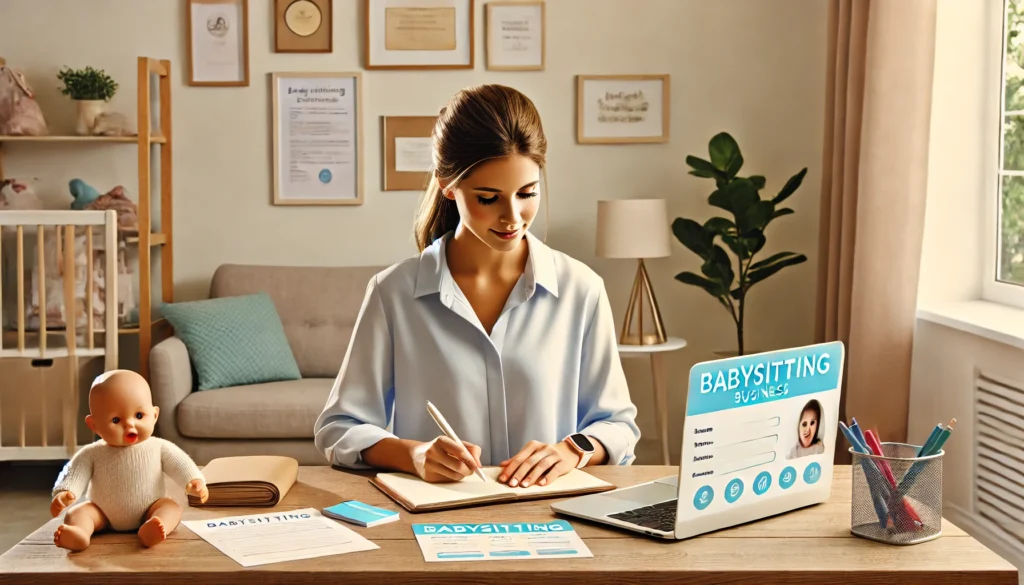
Table of Contents
Introduction: The Modern Babysitting jobs Landscape
In today’s digital-first world, your online babysitting profile serves as your professional storefront. According to recent industry data, the childcare services market is expected to reach $520.4 billion by 2025, with a significant portion represented by independent babysitters and nannies. Understanding how to position yourself in this growing market is crucial for success.
Why Your Profile Matters More Than Ever
The dynamics of babysitting have evolved dramatically in the past decade:
- 87% of parents now begin their babysitter search online
- The average parent spends 3.5 hours researching potential caregivers
- 92% of parents make their initial judgment within 45 seconds of viewing a profile
- Profiles with professional presentations receive 4x more inquiries
- Well-crafted profiles command 35% higher hourly rates
Current Market Analysis
Understanding the current babysitting market helps position your profile effectively:
Market Trends:
- Increased demand for educational components
- Rising importance of health and safety protocols
- Growing preference for tech-savvy sitters
- Higher value placed on specialized skills
- Emphasis on transparency and verification
Building Your Professional Foundation

Creating Your Professional Identity
1. Personal Brand Development
Your personal brand should communicate three key elements:
- Professional capability
- Trustworthiness
- Unique value proposition
Brand Statement Formula:
I am a [qualification] babysitter specializing in [age group/specialty] who provides [unique value] through [specific approach/methodology].Examples:
- “I am a certified early childhood educator specializing in preschool-age children who provides engaging developmental activities through play-based learning.”
- “I am an experienced special needs babysitter specializing in autism spectrum support who provides structured care through individualized attention and routine management.”
2. Visual Presentation
Professional Photo Guidelines:
Primary Profile Photo:
- High resolution (minimum 300 DPI)
- Natural lighting (soft, diffused light)
- Professional but approachable attire
- Neutral background
- Genuine smile
- Clear face visibility
- Recent (within last 6 months)
Supporting Photos:
- Action shots with children (with permission)
- Educational activity demonstrations
- Safe environment examples
- Certification documentation
Photo Session Tips:
- Schedule during “golden hour” lighting
- Use a plain wall as background
- Position yourself at a slight angle
- Maintain good posture
- Consider professional headshots
Comprehensive Experience Documentation
1. Experience Portfolio Development
Create detailed experience entries that showcase your capabilities:
Template for Professional Experience:
Position: [Title]
Duration: [Dates]
Family Details: [Ages of children, special circumstances]
Core Responsibilities:
- [Quantifiable achievement]
- [Specific duty with outcome]
- [Special project or initiative]
Skills Demonstrated:
- [Relevant skill with example]
- [Technical competency with context]
- [Soft skill with demonstration]
Special Achievements:
- [Recognition or accomplishment]
- [Parent testimonial or feedback]
- [Problem solved or challenge overcome]2. Skills Matrix Development
Create a comprehensive skills inventory:
Essential Skills Categories:
- Child Development
- Age-appropriate activities
- Developmental milestone recognition
- Behavioral management
- Educational support
- Safety & Emergency Preparedness
- CPR/First Aid certification
- Emergency response protocols
- Child-proofing expertise
- Safe sleep practices
- Educational Support
- Homework assistance
- Subject-specific tutoring
- Learning activity planning
- Educational game creation
- Special Needs Care
- Autism spectrum experience
- ADHD management
- Sensory processing understanding
- IEP familiarity
- Household Management
- Meal planning and preparation
- Schedule coordination
- Light housekeeping
- Organization systems
Professional Credentials and Qualifications
Essential Certification Path
1. Core Certifications
Priority Level 1 (Must-Have):
- CPR & First Aid Certification
- Provider: American Red Cross
- Cost: $85-120
- Renewal: Every 2 years
- Time commitment: 4-6 hours
- Basic Babysitting Certification
- Provider: American Red Cross or local agencies
- Cost: $45-150
- Duration: Valid for 2 years
- Course length: 6-8 hours
Priority Level 2 (Recommended):
- Child Development Associate (CDA) Credential
- Investment: $425-500
- Requirements:
- 120 hours formal education
- 480 hours experience
- Professional portfolio
- Verification visit
- Early Childhood Education Units
- Provider: Community colleges
- Cost: $100-300 per course
- Benefits:
- Higher pay rate
- Better job opportunities
- Professional credibility
2. Specialized Training
Advanced Qualifications:
- Special Needs Care
- Autism Spectrum Training
- ADHD Management
- Behavioral Intervention
- Communication Techniques
- Educational Support
- Elementary Education Methods
- Learning Styles Theory
- Educational Psychology
- Curriculum Development
- Safety Specializations
- Water Safety Certification
- Food Safety Handling
- Sleep Safety Training
- Emergency Management
Detailed Profile Components
Bio Section Mastery
1. Professional Summary
Your professional summary should follow this structure:
Opening Paragraph:
- Hook statement
- Years of experience
- Key specializations
- Core philosophy
Middle Paragraphs:
- Specific achievements
- Unique approaches
- Special skills
- Educational background
Closing Paragraph:
- Value proposition
- Availability
- Call to action
2. Experience Detailing
Break down your experience into clear categories:
Direct Childcare Experience:
- Age groups served
- Duration of service
- Special circumstances
- Key responsibilities
Related Experience:
- Teaching or tutoring
- Camp counseling
- Youth programs
- Volunteer work
Specialized Experience:
- Special needs care
- Educational support
- Emergency response
- Activity planning
Rate Setting Strategy
1. Base Rate Calculation
Use this formula to determine your base rate:
Market Average + Experience Premium + Skill Premium + Location Factor = Base RateMarket Average Research:
- Local babysitting websites
- Childcare centers
- Parent groups
- Professional associations
Experience Premium Scale:
- 0-1 year: Base rate
- 1-3 years: +$2-3/hour
- 3-5 years: +$3-5/hour
- 5+ years: +$5-8/hour
Skill Premium Additions:
- Education background: +$2-4/hour
- Special needs experience: +$3-6/hour
- Multiple languages: +$2-4/hour
- Advanced certifications: +$2-5/hour
2. Additional Services Pricing
Create a clear additional services menu:
Transportation Services:
- Base rate + $0.58/mile
- Vehicle safety requirements
- Insurance documentation
- Driver record verification
Household Services:
- Meal preparation: +$2-3/hour
- Light housekeeping: +$2-3/hour
- Laundry assistance: +$2-3/hour
- Pet care: +$3-4/hour
Educational Support:
- Homework help: +$3-5/hour
- Tutoring: +$5-10/hour
- Educational activities: +$2-4/hour
- Language instruction: +$5-10/hour
Activity Planning and Educational Support

Age-Appropriate Activity Library
1. Infant Activities (0-12 months)
Sensory Development:
- Texture exploration boards
- Sound recognition games
- Visual tracking exercises
- Safe touch activities
Motor Skills:
- Tummy time variations
- Reaching and grasping games
- Rolling and crawling support
- Assisted standing activities
Cognitive Development:
- Object permanence games
- Simple cause and effect
- Mirror play activities
- Pattern recognition
2. Toddler Activities (1-3 years)
Physical Development:
- Balance exercises
- Coordination games
- Fine motor activities
- Gross motor play
Language Development:
- Story time routines
- Song and rhyme activities
- Picture naming games
- Simple conversation practice
Social Skills:
- Turn-taking games
- Sharing exercises
- Emotional recognition
- Group play introduction
3. Preschool Activities (3-5 years)
Academic Foundations:
- Letter recognition games
- Number concept activities
- Shape sorting challenges
- Color mixing experiments
Creative Expression:
- Art projects
- Music and movement
- Dramatic play
- Storytelling exercises
Problem Solving:
- Simple puzzles
- Pattern creation
- Basic science experiments
- Building challenges
4. School-Age Activities (6-12 years)
Academic Support:
- Homework assistance
- Study skills development
- Project planning
- Research guidance
Life Skills:
- Time management
- Organization techniques
- Basic cooking skills
- Money management
Physical Activities:
- Sports practice
- Dance and movement
- Outdoor adventures
- Team games
Safety and Emergency Preparedness
Comprehensive Safety Protocols
1. Home Safety Assessment
Room-by-Room Checklist:
Living Areas:
- Furniture anchoring
- Cord management
- Sharp corner protection
- Window safety
Kitchen:
- Chemical storage
- Knife security
- Appliance safety
- Food safety protocols
Bathrooms:
- Medicine security
- Water temperature checking
- Slip prevention
- Electric safety
Outdoors:
- Gate security
- Play equipment inspection
- Surface safety
- Sun protection
2. Emergency Response Plans
Medical Emergencies:
- First aid procedures
- Emergency contact list
- Hospital directions
- Insurance information
Natural Disasters:
- Evacuation routes
- Meeting points
- Emergency supplies
- Communication plan
Security Incidents:
- Lock-down procedures
- Safe rooms
- Police contact
- Parent notification
Professional Development and Growth
Career Advancement Plan
1. Short-Term Goals (0-6 months)
Certification Completion:
- Basic certifications
- Safety training
- Specialized courses
- Professional memberships
Profile Development:
- Professional photos
- Experience documentation
- Reference collection
- Rate structure
2. Medium-Term Goals (6-12 months)
Skill Enhancement:
- Advanced certifications
- Specialized training
- Educational courses
- First aid updates
Business Development:
- Client base expansion
- Service diversification
- Rate adjustments
- Marketing strategies
3. Long-Term Goals (1-2 years)
Professional Achievement:
- Leadership roles
- Mentoring opportunities
- Industry recognition
- Business expansion
Educational Advancement:
- Degree programs
- Advanced certifications
- Specialized training
- Professional development
Conclusion
Creating a 5-star babysitting profile is an ongoing process that requires attention to detail, continuous improvement, and professional development. By following this comprehensive guide, you’ll be well-equipped to create a profile that stands out in the competitive childcare market.
Remember to:
- Update your profile regularly
- Continue your education
- Maintain professional standards
- Build strong relationships
- Track your progress
- Adapt to market changes
Your success in babysitting depends on your commitment to excellence and your ability to communicate that excellence through your profile. Stay focused on quality, safety, and professional growth, and you’ll build a rewarding career in childcare.
Additional Resources
For ongoing support and development, consult these resources:
- American Red Cross Babysitting Resources
- Child Care Aware of America
- National Association for the Education of Young Children
- Zero to Three


